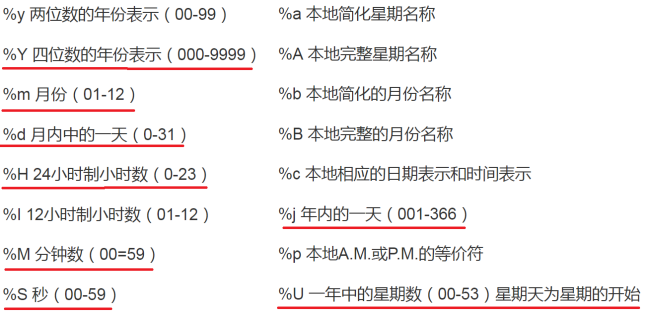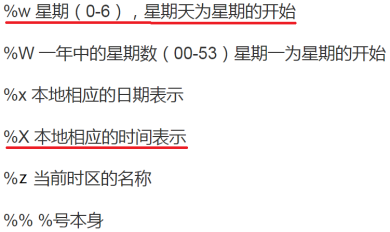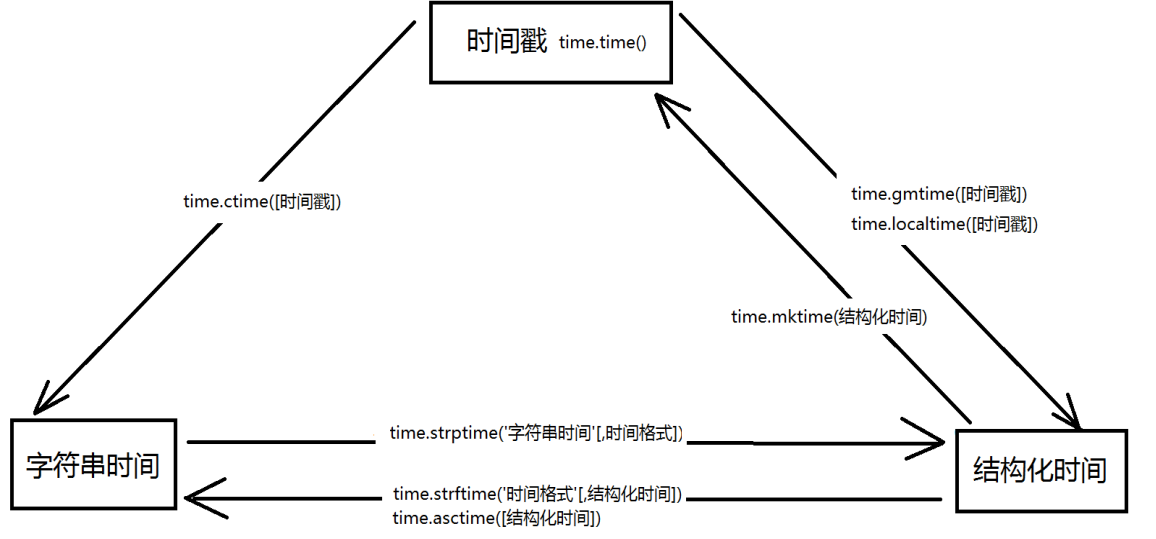python中时间的表示方式 unix时间戳,字符串时间,格式化时间
时间模块有,time,datetime,calendar
#time模块
import time #获取本地时间戳,返回浮点数 print(time.time()) #1566201346.1516223 #获取结构化时间 time.gmtime([时间戳]) ##,不传时间戳默认为当前UTC时间 print(time.gmtime()) #time.struct_time(tm_year=2019, tm_mon=8, tm_mday=19, tm_hour=7, tm_min=56, tm_sec=39, tm_wday=0, tm_yday=231, tm_isdst=0) time.localtime([时间戳])#不传时间戳默认为当前本地时间 print(time.localtime()) #time.struct_time(tm_year=2019, tm_mon=8, tm_mday=19, tm_hour=15, tm_min=58, tm_sec=53, tm_wday=0, tm_yday=231, tm_isdst=0) #将结构化时间转为时间戳 time.mktime(结构化时间) print(time.mktime(time.localtime())) #1566201588.0 #字符串时间 #time.asctime([结构化时间]) #不传参默认值为time.localtime() print(time.asctime(time.localtime())) #Mon Aug 19 16:01:26 2019 time.ctime([时间戳]) #不传参默认值为time.time() print(time.ctime()) #Mon Aug 19 16:08:18 2019 #结构化时间转换为字符串时间 #time.strftime('时间格式'[,结构化时间]),结构化时间默认值为time.localtime() print(time.strftime('%Y-%m-%d %H:%M:%S')) #2019-08-19 16:11:47 print(time.strftime('%Y-%m-%d %X')) #2019-08-19 16:13:15


#字符串时间转化为格式化时间 #time.strptime('字符串时间'[,时间格式]) #时间格默认值为 %a %b %d %H:%M:%S %Y #字符串时间必须和时间格式对应 print(time.strptime('Thu Jun 28 10:10:10 2018')) #time.struct_time(tm_year=2018, tm_mon=6, tm_mday=28, tm_hour=10, tm_min=10, tm_sec=10, tm_wday=3, tm_yday=179, tm_isdst=-1) print(time.strptime('2019-08-19 16:18:10','%Y-%m-%d %H:%M:%S')) #time.struct_time(tm_year=2019, tm_mon=8, tm_mday=19, tm_hour=16, tm_min=18, tm_sec=10, tm_wday=0, tm_yday=231, tm_isdst=-1) #指定程序暂停运行时间 #time.sleep(secs):程序暂停运行指定的秒数 time.sleep(5) #程序暂停运行五秒
时间关系转换图

#datetime模块
相比于time模块,datetime模块的结构则更直观、更容易调用
datetime模块定义了5个类,分别是
datetime.date:表示日期的类
datetime.time:表示时间的类
datetime.datetime:表示日期时间的类
datetime.timedelta:表示时间间隔,即两个时间点的间隔
datetime.tzinfo:时区的相关信息
from datetime import datetime #datetime.datetime (year, month, day, hour , minute , second) #返回表示今天本地时间的datetime对象 print(datetime.today()) #2019-08-19 16:26:06.777756 #返回表示当前本地时间的datetime对象 print(datetime.now()) #2019-08-19 16:28:25.854710 #根据时间戮创建一个datetime对象 print(datetime.fromtimestamp(time.time())) #2019-08-19 16:29:44.365201 #datetime对象操作 dt = datetime.now() print(dt.date()) #2019-08-19 print(dt.time()) #16:33:38.263579 #返回替换后的datetime对象 print(dt.replace(year=2022,month=9,day=10)) #2022-09-10 16:35:39.721526 #按指定格式返回datetime对象 print(dt.strftime('%Y/%m/%d %H:%M:%S')) #2019/08/19 16:37:38
#datetime.timedelta
timedelta主要用来实现时间的运算
使用timedelta可以很方便的在日期上做天,小时,分钟,秒的时间计算,如果要计算月份则需要另外的办法
from datetime import datetime,timedelta dt = datetime.now() dt1 = dt + timedelta(days=-1) #昨天 dt2 = dt - timedelta(days=1) #昨天 dt3 = dt + timedelta(days=1) #明天 dt4 = dt + timedelta(hours=10) #10小时后 print(dt1,dt2,dt3,dt4) #2019-08-18 16:44:27.535715 2019-08-18 16:44:27.535715 2019-08-20 16:44:27.535715 2019-08-20 02:44:27.535715 print(dt + timedelta(days=10,hours=100,minutes=100,seconds=100,milliseconds=100,microseconds=100)) #2019-09-02 22:28:49.705085
#calendar模块
import calendar #获取指定年份的日历字符串 print(calendar.calendar(2019)) #获取指定月份的日历字符串 print(calendar.month(2019,8)) August 2019 Mo Tu We Th Fr Sa Su 1 2 3 4 5 6 7 8 9 10 11 12 13 14 15 16 17 18 19 20 21 22 23 24 25 26 27 28 29 30 31 #以列表形式返回每个月的总天数 print(calendar.mdays) #[0, 31, 28, 31, 30, 31, 30, 31, 31, 30, 31, 30, 31] #返回指定月份的第一是周几以及每月的总天数 print(calendar.monthrange(2020,9)) (1, 30)
#一些习题
#第一题:打印出当前距2019年8月1日有多少天多少小时多少分多少秒 from datetime import datetime import calendar #两个日期之间的差为 cha=datetime(2019,8,1)-datetime.now() # print(cha) #相差的天数 days=cha.days #方法一: #将cha分割成列表 cha_list1=str(cha).split() cha_list2=cha_list1[2].split(':') # print(cha_list2) print("相差%d天%d小时%d分%d秒"%(days,int(cha_list2[0]),int(cha_list2[1]),int(cha_list2[2][:2]))) #相差小时数 #方法二: #所剩余秒数为 remain_seconds=cha.seconds #print(remain_seconds) #相差的小时数 hours=remain_seconds//3600 #相差的分钟数 minutes=remain_seconds%3600//60 #相差的秒数 seconds=remain_seconds%60 print("相差%d天%d小时%d分%d秒"%(days,hours,minutes,seconds)) #输出 相差-19天6小时54分8秒 相差-19天6小时54分8秒
#第二题:打印出20个月之后的日期 #当前的时间为 #cur=datetime.now() def getDate(cur,m): #当前年 year=cur.year #当前月 month=cur.month #当前日 day=cur.day #print(year,month,day) #算出20个月的year month day #总的月数 total_month=m+month #需要增加的年数 y_plus=total_month//12 #新的月份 new_month=total_month%12 #0 1 2 .....11 #判断新的月份为0的情况 if new_month==0: y_plus-=1 new_month=12 #判断当前的天数是否大于新的月份的总天数,如果比新月份总天数大,则把月份加1,再算出新的天数 #新月份的总天数 mdays=29 if new_month==2 and calendar.isleap(year+y_plus) else calendar.mdays[new_month] if mdays<day: #new_month+=1 #新的天数 day=mdays #20个月之后的日期 2018 new_date=cur.replace(year=year+y_plus,month=new_month,day=day) print(new_date) #输出 2021-04-19
打印出现在时间(字符串) print(datetime.today()) #2019-08-17 16:45:34.339610 print(datetime.now()) #2019-08-17 16:45:34.339609 print(datetime.now().strftime('%Y-%m-%d %H:%M:%S')) #2019-08-21 12:26:19
打印出指定格式的日期 2018年5月7日 星期六 08:01:02 def get_week(w): if w=='1': week='星期一' elif w=='2': week='星期二' elif w=='3': week='星期三' elif w=='4': week='星期四' elif w=='5': week='星期五' elif w=='6': week='星期六' else: week='星期日' return week # 字符串转换为格式化,拿到星期几 s_time=time.strptime('2018-05-07 08:01:02','%Y-%m-%d %H:%M:%S') w1=time.strftime("%w",s_time) # 指定格式输出 print(time.strftime("%Y{}%m{}%d{} {} %H:%M:%S",s_time).format('年','月','日',get_week(w1))) ###2018年05月07日 星期一 08:01:02
打印出当前距离指定时间差多少天,多少时,多少分,多少秒 from datetime import timedelta def cha(year,month,day): a=datetime(year,month,day)-datetime.now() print('当前时间距%s年%s月%s日还有%s天%s时%s秒'%(year,month,day,a.days,a.seconds//3600,a.seconds%60)) cha(2021,3,1)##当前时间距2021年3月1日还有559天8时22秒
一、有一个人从2015-01-01开始过上了三天打渔两天晒网的日子,问今天该打渔还是晒网?明年的今天呢 from datetime import datetime def dy_sw(year,month,day): dt = datetime(year,month,day)-datetime(2015,1,1) if dt.days%5<3: print('打渔') else: print('晒网') dy_sw(2019,8,23) #输出 打渔
done。